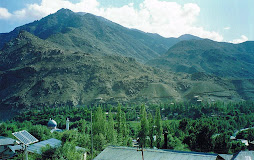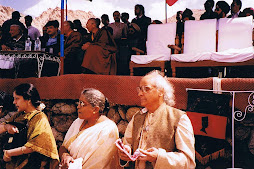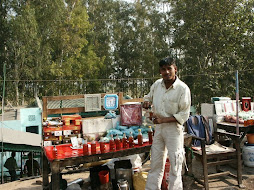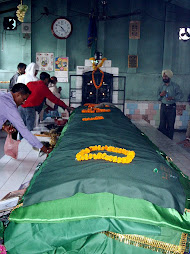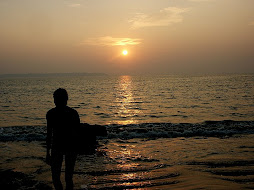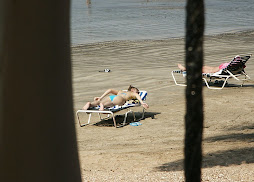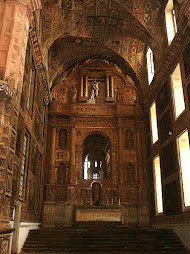After retirement, I was packing my belonging to shift to new house as I had to vacate Government accommodation. I had collected lot papers and photographs during my years of service .A photograph of my visit to Chushul brought back memories of Chushul.
I had accompanied Mr Ram Vilas Paswan the then Miniser of Communication, on his visit to Leh and forward areas of Ladakh during first week of September 2000. Highlights of trip were visits to Siachen ,Thoise and Daulat Beg Oldi. Incidentally, Mr George Fernandes was also present at Thoise. After Inauguration of Satellite Earth station, we moved over to Daulat Beg Oldi. Here the programme was to hand over Inmarsat telephones to Indo Tibetan Border Police (ITBP) personnel posted at this remote post. Inmarsat phone would bring them in close contact with families and friends. DOT as a special gesture to armed forces in Ladakh had provided Inmarsat phones on normal STD PCO charges. Next day’s programme was to go to Chushul to handover telephones .Chushul as readers will recall was last village Chima had stopped due to stiff resistance offered by Indian Army.

Part Map of Ladakh(source Internet)
Battle of Rezang La in Chushul sector has a proud place in memory of Indians, who were demoralized by defeat at hands of Chinese in 1962. Chushul is remembered by Indians because of heroic resistance offered by Major Shaitan Singh and his jawans of 13th Kamaou Battalion .I did some research on Internet to bring out history of Battle of Rezang-La in Chushul sector.

Traditional welcome at Chushul air strip
Chushul is at height of about 4300 meters above sea level. It is a small village in a narrow sandy valley about 40Kms long and 6 Kms wide, flanked by mountains that rise to over 6000 m. At the northern end touches the Pangong Tso, a deep saltwater lake nearly a 160 Kms long. It is popular tourist destination for people visiting Leh. Near Chushul there is a gap in the mountains called the Spanggur Gap that leads to another beautiful lake called Spanggur Tso which also extends well into Chinese territory.

Pangong Tso
During the 1962 Indo-China conflict, 13 Kumaon was deployed in Chushul sector. The C Company of the battalion led by Major Shaitan Singh held a crucial position at Rezang La. The company area was defended by three platoon positions and the surrounding terrain isolated it from the rest of the battalion. This was a massive feature of 5180 metres. They were deployed over a 2 km frontage with a total of 118 men. The 3 platoons namely 7th was 3000 m north of the pass, 9th led was 1000 m south of 7th platoons position and 8th platoon was deployed a further 1400 m south with company headquarters behind them along with the 3 inch mortars. Although they were well entrenched they did not have mines as well as adequate overhead protection for the command posts.
Rezang La was attacked on November 18th in the morning. At 0500 hours when the visibility improved both platoons opened up on the advancing enemy with rifles, light machine guns, grenades and mortars. The survivors took position behind boulders and the dead bodies. The enemy subjected Indian positions to intense artillery and mortar fire. Soon about 350 Chinese troops commenced advance. This time, No.9 Platoon, which held fire till the enemy was within 90 meters opened up with all weapons in their possession. Within minutes, the enemy was reduced to a number of dead bodies.
Unsuccessful in frontal attack, the enemy comprising about 400 soldiers, attacked from the rear of the company position. They simultaneously opened intense MMG (medium machine gun) fire on the No.8 Platoon. This attack was restricted. The enemy then resorted to heavy artillery and mortar shelling.
An assault group of 120 Chinese then charged the No.7 Platoon position from the rear. However 3 inch Indian mortar killed many of them. When 20 survivors charged the post, about a dozen Kumaonis rushed out of their trenches to engage them in a hand-to-hand combat. Meanwhile, the enemy brought up fresh reinforcements. The encirclement of the No.7 Platoon was now complete. The platoon, however, fought valiantly till there was no survivor. No.8 Platoon also fought bravely to the last man and last round.*
Major Shaitan Singh, the Company Commander, displayed exemplary leadership and courage in the battle of Rezang La. He led his troops most admirably. Unmindful of his personal safety, he moved from one platoon post to another and encouraged his men to fight. While moving among the posts he was seriously wounded. But he continued to fight along with his men.
Major Shaitan Singh was being evacuated by two of his comrades. The Chinese brought heavy machine gun fire on them. Major Shaitan Singh sensed danger to lives of his jawans and ordered them to leave him. They placed him behind a boulder on the slopes of a hill, where he breathed his last. In this action, 109 Kumaonis were killed. The Chinese suffered much greater losses. After the war was over, the body of Major Shaitan Singh was found at the same place. It was flown to Jodhpur and cremated with full military honours and later posthumously awarded Param Veer Chakra.
Major Shaitan and jawans succeeded in blunting the Chinese attack killing about 1000 Chinese. Thereafter, the Chinese did not push further towards Chushul. The story of valor of Major Shaitan Singh and his men brought sense of pride to Indians in those depressing days, when Indian armed forces were outnumbered and over run in many of battles in Eastern and Western Sectors. A small memorial has been erected at Chushul which says:

“How can a Man die Better than facing Fearful Odds,
For the Ashes of His Fathers and the Temples of His Gods”,
To the sacred memory of the Heroes of Rezang La,
114 Martyrs of 13 Kumaon who fought to the Last Man,
Last Round, Against Hordes of Chinese on 18 November 1962.
Built by All Ranks 13th Battalion, The Kumaon Regiment.
* Source : Battle of Chushul by L N Subramanian

Major Shaitan Singh
Citation for Award of Param Vir Chakra to
Major Shaitan Singh
CITATION
1. Major Shaitan Singh was commanding a company of an infantry battalion deployed at Razangala in the Chushul Sector at a height of about 17,000 feet. The locality was isolated from the main defended sector and consisted of five defended platoon positions. On 18 November 1962, the Chinese subjected the company position to heavy artillery, mortar and small arms fire and attacked in overwhelming strength in successive waves. Against heavy odds, our troops beat back the enemy attack. During the action, Major Shaitan Singh dominated the scene of operations, and moved at great personal risk from one platoon post to another sustaining the morale of his hard-pressed platoon posts. While doing so he was seriously wounded but continued to encourage and lead his men who, following his brave example, fought gallantly and inflicted heavy casualties on the enemy. For every man lost by us, the enemy lost four to five. When Major Shaitan Singh fell disabled by wounds in his arms and abdomen, his men tried to evacuate him but came under heavy machine gun fire. Major Shaitan Singh ordered his men to leave him to his fate in order to save their lives.
2. Major Shaitan Singh`s supreme courage, leadership and exemplary devotion to duty inspired his company to fight almost to the last man.
Ramesh Lalwani
18.12 2005



















































